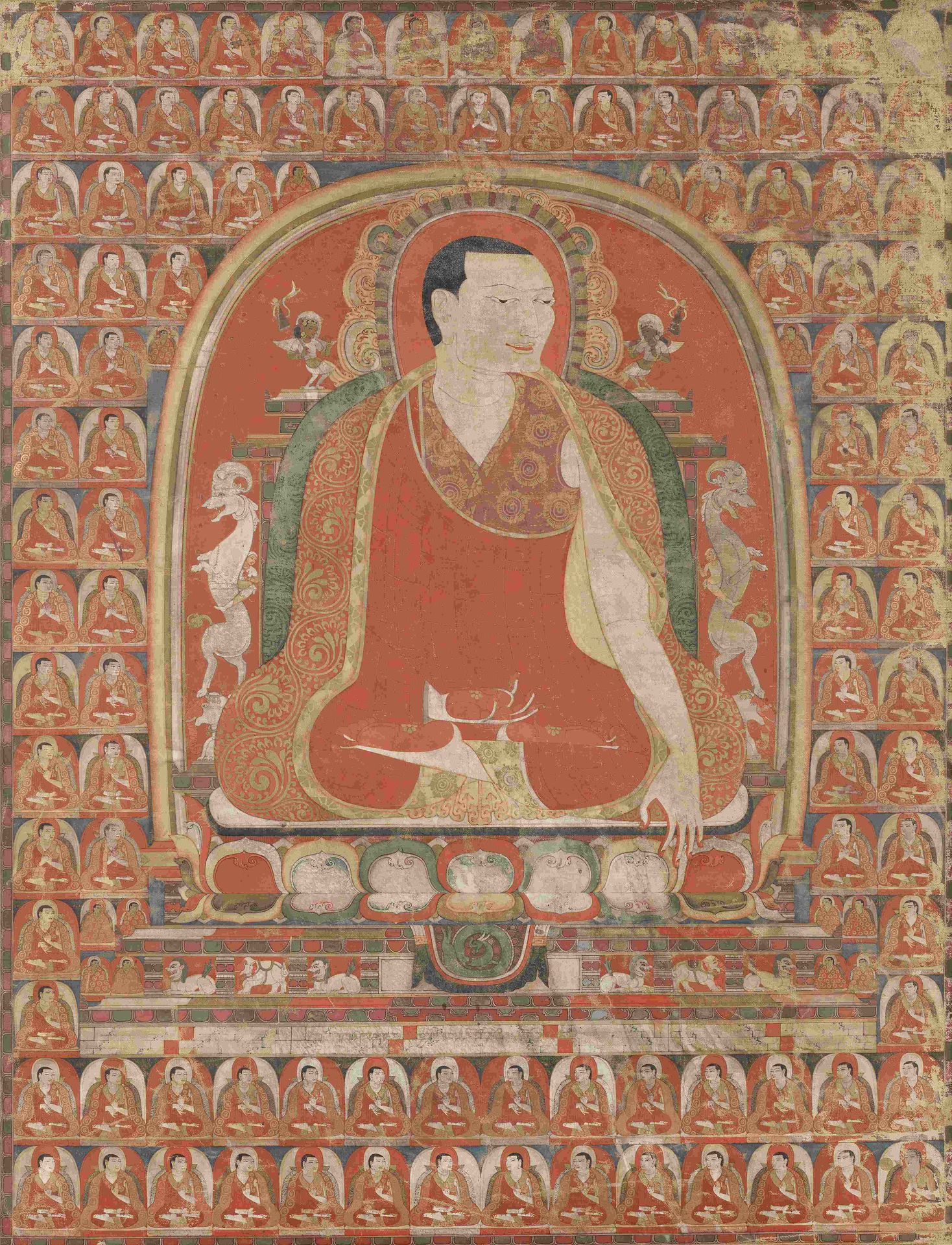Descrizione
TANGKA REPRÉSENTANT LE PORTRAIT DU TROISIÈME ABBÉ DU MONASTÈRE DE TAKLUNG, S...
TANGKA REPRÉSENTANT LE PORTRAIT DU TROISIÈME ABBÉ DU MONASTÈRE DE TAKLUNG, SANGYE YARON (PRAJNAGURU) TIBET CENTRAL, COMMANDÉ POUR LE MONASTÈRE DE TAKLUNG, VERS 1236-1272 Distemper on cloth; recto with a Tibetan inscription in gold below the throne: bla ma rin po che dpon po dpal gyi thugs dam lags//; 'This is the thugs dam ['the meditative commitment' or 'high aspiration'] of the Honorable Onpo Lama Rinpoche. Verso with inscribed Tibetan mantras in black ink and an invocation: ōṃ a na mo rad na ghu ru prad jña ghu ru hūṃ// Verso also with a Tibetan inscription in gold: mtshungs med bla ma dam pa pradznya 'ghu ru dang// bdag 'ghir ti shri ra smri bha tra 'bral med ci gsung bka' bsgrub cing/ rangs sems 'khrul pa dag pa dang// 'gro 'ba'i 'dren pa nus par shog//; 'May I, Kirtiśrī Rashmibhadra, being inseparable from the incomparable holy lama Prajñāguru, achieve whatever he commands, and may I have the power to purify the bewilderment of my own mind and act as a guide for living beings.' Himalayan Art Resources item no. 4552 Image: 82 x 63 cm (32 1/4 x 24 7/8 in.) Footnotes: A PORTRAIT THANGKA OF THE THIRD ABBOT OF TAKLUNG MONASTERY, SANGYE YARJON (PRAJNAGURU) CENTRAL TIBET, COMMISSIONED FOR TAKLUNG MONASTERY, CIRCA 1236-1272 達隆寺第三任堪布桑傑雅俊(般若上師)肖像唐卡 藏中 達隆寺施造 約1236-1272年 Published: Jane Casey Singer and Phillip Denwood, Tibetan Art: Toward a Definition of Style, London, 1997, p. 63, no. 45. Jane Casey, Taklung Painting: A Study in Chronology, Serinda Publications, forthcoming 2023. Provenance: Mimi Lipton, acquired 1985 This rare and early Tibetan painting depicting Sangye Yarjon surrounded by 108 further manifestations is to-date the only known Taklung portrait with this arrangement at this larger scale. The composition echoes the account of Buddha Shakyamuni's miraculous ability to multiply himself, conveying omnipresence, something only an enlightened being that has progressed fully to the point of Buddhahood can do. Elsewhere in the painting, through a hand gesture or by being seated on a lotus throne, Sangye Yarjon's image is again conflated with that of the historical Buddha. Meanwhile, fine textiles worn for his monastic robes and draped over the front of his throne draw association with courtly attire and motifs of Central and East Asian ruling classes. As the third abbot of Taklung monastery, Sangye Yarjon is represented as both a spiritual and worldly potentate. Sangye Yarjon's throne is dressed with a piece of textile, likely representing silk or very fine cotton, draped over the center of the rectangular plinth. Like many sumptuous throne covers featured in Taklung portraits, this one has multi-colored floral patterning, ruffled borders, and projecting corners. However, more rarely, it also depicts an animal or mythological creature. Other examples, for instance, feature a pair of snow lions below a portrait of Shangton Choki Lama (Denwood & Casey Singer, Tibetan Art , 1997, p. 64, no. 46), or peacocks below Taklung Tangpa Chenpo (Pritzker Collection; HAR 58362). In this portrait of Sangye Yarjon, the center cloth bears a coiled green aquatic dragon, or panlong, resembling an ancient motif in Chinese mythology and art, and one that is not depicted in other Taklung portraits. The coiled panlong motif appears on princes' robes dating to the Tang dynasty (618-907), and was also used in the Song (960-1276), Xi Xia (1038-1227), and Jin (1115-1234) dynasties. A Jin-dynasty embroidered silk panel with such a design is in the collection of the Metropolitan Museum of Art, New York (1989.205; fig. A). The occurrence of this motif within a Taklung portrait reflects the thoroughfares of trade and gift-exchange, and the esteem associated with refined Chinese textiles among the Tibetan ruling class. Imported luxury textiles are ubiquitous in Taklung portraits of the 13th century, with notable attention placed on the embroidered patterns of each leader's robes. Here, large continuously scrolling abstracted gold flower heads embellish Sangye Yarjon's meditation cloak. The treatment is redolent of Cizhou pottery, as seen, for example, on a 12th-13th-century earthenware pillow in the Minneapolis Institute of Art (2000.42; fig. B). The abbot's inner vest patterned with gold foliate roundels on a maroon ground also recalls the Metropolitan's Jin-dynasty textile, which presents similar spacing over a solid color. This merging of worldly and spiritual status evokes an archetype of Buddhist kingship
101
TANGKA REPRÉSENTANT LE PORTRAIT DU TROISIÈME ABBÉ DU MONASTÈRE DE TAKLUNG, S...
